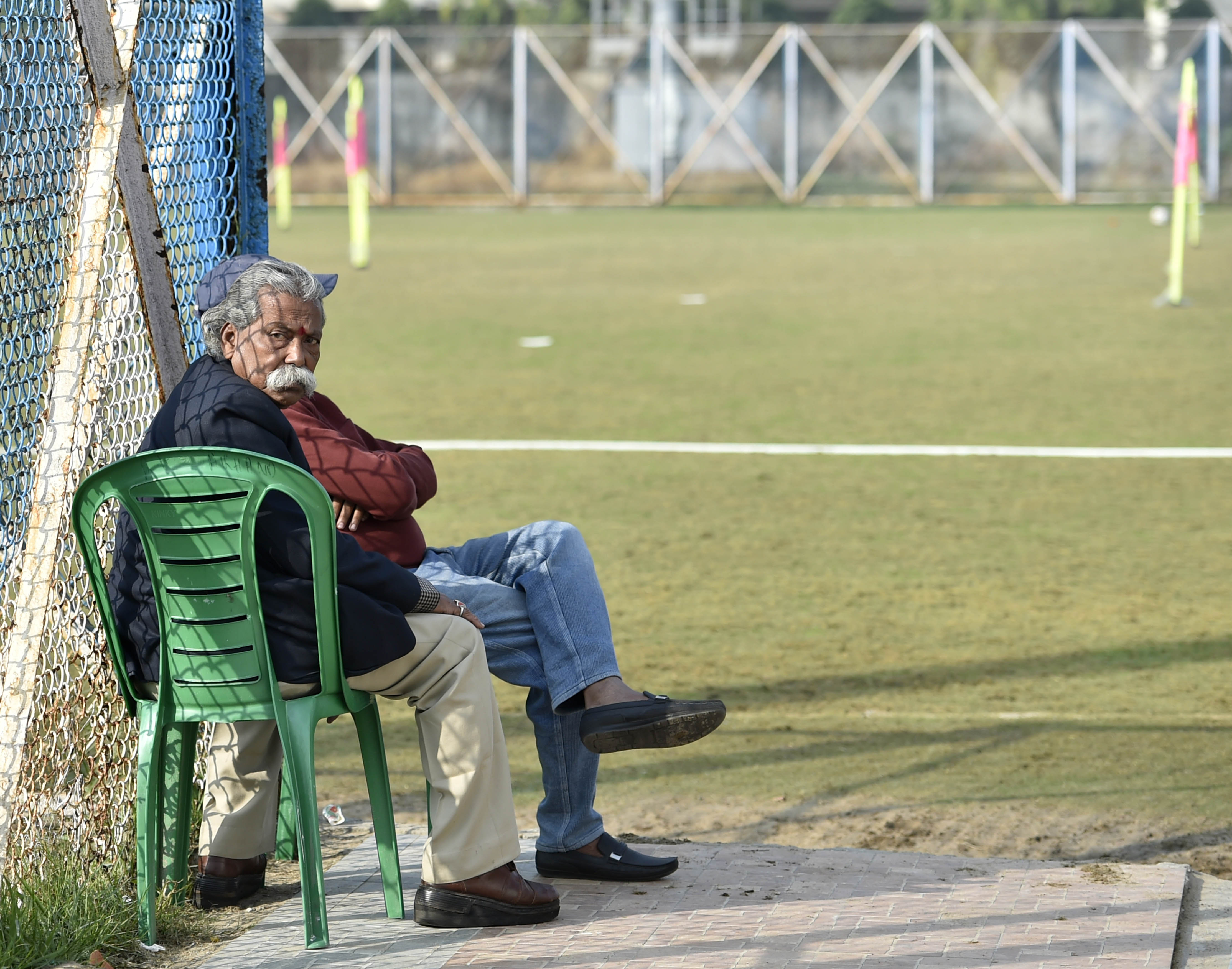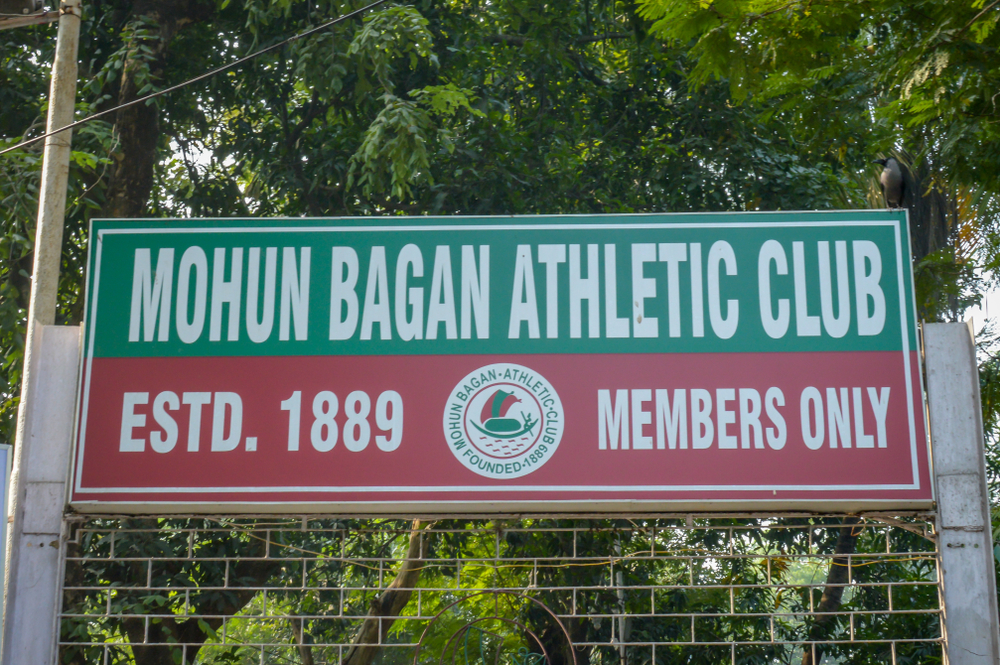At 74, Kumaresh Saha’s day begins like this. Wake up early, have breakfast, do morning puja — “Kali Ma is with me always,” he says — and head straight for East Bengal Football Club’s practice session. After that, if there is a match of the club’s cricket team at Eden or anyplace else, he goes there. In the evening, if there is any work at the East Bengal tent in the Maidan, he goes there too. “This has been the routine since I opted for voluntary retirement in 2001,” says the former bank employee.
And yet nobody has heard of a Kumaresh Saha in the Maidan. That is the lair of Kalida. Saha says with a chuckle, “Everyone here knows me as Kalida; even a blade of grass.” In the olden days, whenever East Bengal won a title, the responsibility of distributing bhaanrs of rosogolla devolved unto him.
I am meeting Kalida at the Eden Gardens’ lobby. It is evening and a local league match has been called off because of poor light. He has just arrived from the Salt Lake Stadium where East Bengal were practising under coach Alejandro Menendez Garcia. “We have an important I-League match coming up. There is the Derby too,” he says. Of late, and quite understandably, Kalida’s knees cannot cope with the football fan’s frenzied spirit.

East Bengal and Mohun Bagan supporters (File picture by Suman Ballav)
He fell in love with the game in the 1950s. “Those days we were in Jessore, now in Bangladesh. My father brought me to Calcutta to watch East Bengal play. I remember watching Ahmed Khan caressing the ball. That’s it, my life changed. After we migrated, I became a regular at the stands. That was 1960-61,” he says.
He has many stories to tell. Like the time he jumped with joy when Tulsidas Balaram scored and he was sitting amongst Mohun Bagan fans. Another day he got carried away and used a cuss word without realising that former East Bengal official, the late Dipak (Paltu) Das, was sitting ahead of him. “Aqueel Ansari with a swerve of his body had opened the face of Mohun Bagan goal. I couldn’t control myself and used a slang,” he recalls biting his tongue in classic embarrassment.
This is not just Kalida’s story. But Kalida’s story is the story of the ubiquitous football fan of Bengal, a creature of impulse, for whom a football match is always much more, and a football club is home and shrine and a way of life.
It is sheer coincidence that the protagonist of Rudraprasad Sengupta’s iconic play, Football, was also called Kali. “Amar naam Kali, loke bole Byomkali. That was the line,” Sengupta recalls. Football was staged for the first time in the 1970s; an adaptation of British playwright Peter Terson’s Zigger Zagger. Sengupta used Terson’s work to explore the angst of the youth of Bengal. “Amidst the gloom of the time, the youth wanted something to cling on to and football was their refuge,” he tells me.
While the protagonist of Zigger Zagger was a Manchester City fan, in Football Kali rooted for East Bengal. Says Sengupta, “In the greenroom on the first day of the play, actor and playwright Ajitesh Bandopadhyay enquired if Mohun Bagan fans would be upset but everyone said it is not about East Bengal or Mohun Bagan.”
Football ran for more than 400 evenings. “Wherever I went, people used to call me Kalida,” Sengupta remembers fondly.
For Sengupta’s Kalida, football was oxygen. The thespian narrates, “In the last scene, Kali is seen working in a factory. The railings of the factory seem like a jail to him, hemming him in. But he has his transistor. East Bengal are playing that day and though he cannot be at the ground, the airwaves transport him.”

Kalida of Maidan (Sudipto Bhowmik)
I have seen the same glimmer of passion on field. One particular day comes to mind. Year: 1991. Month: August. East Bengal were playing Eastern Railways in a Calcutta Football League match. Braving the rain, spectators stood outside the ticket counters since noon. A man in his 60s, clad in dhuti-panjabi was among them. When the counters opened, the queue started to move at snail’s pace and then came the real challenge for the elder. There was a small nullah that had to be crossed. The younger lot vaingloriously leapt over it. But the elderly man, without any ado, stepped right in and waded his way through it. In dhuti caked with mud and slush he waited the next two hours for the kick-off. That day, East Bengal won the match and the title without conceding a single goal.
It is the same admixture of sentiment and involvement that I hear in Amitava Mallick’s voice. The septuagenarian is a Mohun Bagan supporter. He recalls how during his schooldays he would rush home, stuff his face and leave for the Mohun Bagan ground. His pitch climbs as he talks about Chuni Goswami’s body feint and Sailen Manna’s free-kicks.
Says Ranabir Sengupta, 73, “After East Bengal equalised in the 1966 IFA Shield final against Eastern Railways, I shouted so hard that my friends feared blood would spurt from my mouth. Then there was the 1984 Shield final against Mohun Bagan. After Karthik Seth scored, I cheered so loud that the landlord’s startled daughter dropped a bottle.”
Saumitra Sengupta, a doctor in the UK, is younger to Mallick and Ranabir by a decade and some more, but he shares their passion. In early 2019, when he was visiting Calcutta, he decided to catch an East Bengal versus Indian Arrows I-League match. It was his first time in the stands since he left India in the early 1990s.

East Bengal supporters on their way to Salt Lake Stadium (File picture by Tapan Das)
Rudraprasad Sengupta’s narration of the golden run of Football follows his expression of deep disappointment of living a much-altered context. And when he says, “Everything has changed. The face of fanaticism is now different from 1977,” I suspect he is talking about politics and football.
Saumitra is also nursing a regret after he returned to the football ground. He says, “People taking selfies and chatting over phone… For us the match used to be about life and death.”
The madness surrounding Bengal’s most enduring battle — perhaps most endearing too — started to wane in the early 1980s. Violence had claimed 16 lives during the Calcutta Football League derby in 1980. That was followed by the 1982 and 1984 Nehru Gold Cup at the Eden Gardens and Diego Maradona’s 1986 World Cup. Says sports historian and ardent Mohun Bagan fan Subhransu Roy, “If the 1980 incident made people sceptical about going to the ground, fans were swept off their feet by what they saw at the Nehru Cup and in 1986. They were no longer interested in the derbies. Then the 1997 Federation Cup semifinal happened. And suddenly the interest was back.”
The Federation Cup semifinal clash between East Bengal and Mohun Bagan is part of folklore. Over 1,30,000 spectators watched Bhaichung Bhutia’s East Bengal run roughshod over a hapless Mohun Bagan. The end result was a 4-1 win in favour of East Bengal. “The match made a huge impact on the minds of young fans. Also, the advent of the National Football League, wherein teams from all over the world play on a home-and-away basis, lent a much-needed traction to the sport and fans were back in the aisles,” he reasons.
A new wave brought with it a new league of fans. They started creating online forums wherein they could interact. Sanmit Sarkar was one of the first Mohun Bagan fans to form an online group called Sabuj Maroon Swapno on the now defunct Orkut.

Women fans (Sudipta Bhowmick)
Today, there is a glut of fan groups on Facebook. And then there are tifos. Tifo is Italian for choreography displayed by fans in the stands of an arena or stadium in connection with a sport event. The fan group, East Bengal Ultras, claims the 10,000 square feet tifo unfurled before the 2019 match against Real Kashmir FC on December 4 cost them Rs 70,000. “We raise funds through memorabilia sales and contributions from our members,” says Hrisav Bhowmick of East Bengal Ultras.
Women football fans are no longer oddities. Teacher Paramita Roy makes it a point to be at the ground whenever Mohun Bagan play. Then there are young people like Proma Sanyal. Says the 26-year-old content researcher, “I have watched the Oliver Kahn testimonial game in 2008 and the Lionel Messi game in 2011 with my parents. But the first time I went to see an East Bengal match was in 2013. It was a Calcutta Football League match against Tollygunge Agragami and East Bengal retained the title.” For Proma, Roger Federer and Barcelona come second and third in the pecking order. “East Bengal were, are and will always remain the favourites.”
There are others like the middle-aged Jamuna Das or Lozenges Didi, as she is known in the Maidan. For her East Bengal is everything. With a bagful of candies slung across her shoulders, the travelling saleswoman struts around the Maidan or Salt Lake Stadium; on derby day her earnings multiply. “If East Bengal win, that’s a double delight for me,” she says. She has even travelled to Siliguri and Odisha to watch East Bengal play Mohun Bagan. And she was in Goa when East Bengal played Churchill Brothers earlier this January.
According to Paramita, a clear measure that the female fandom is not lagging in passion or adrenalin is their adoption of the field expletives. She says, “Now I have some good gaalis in my stock.”
Level playing field did you say?













